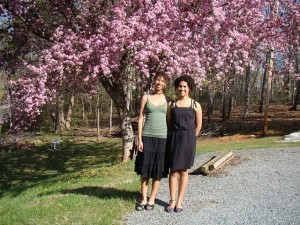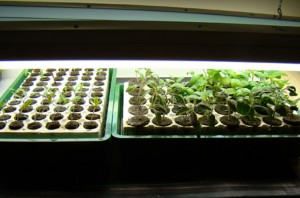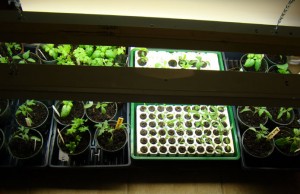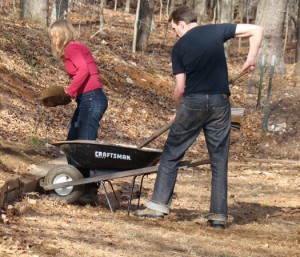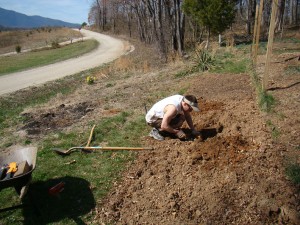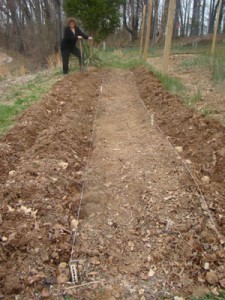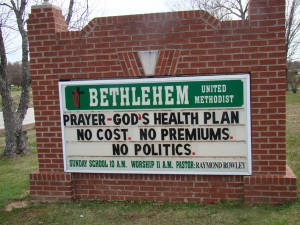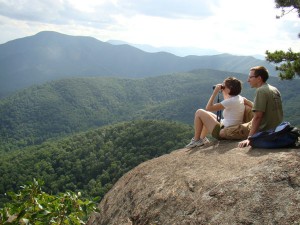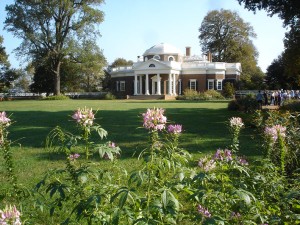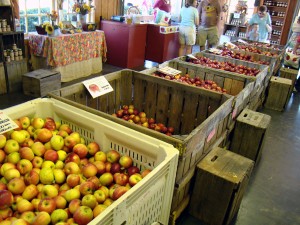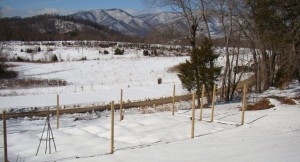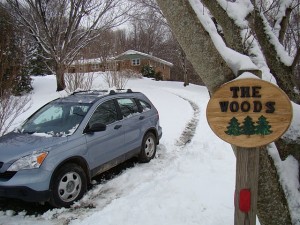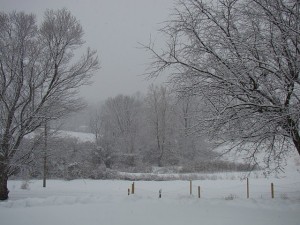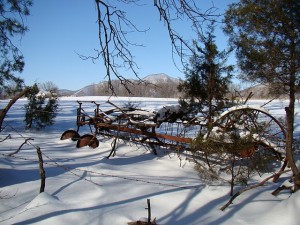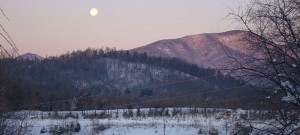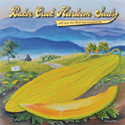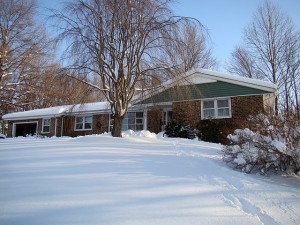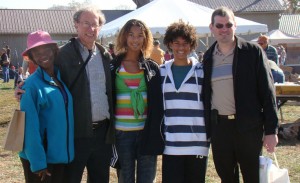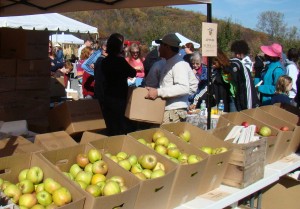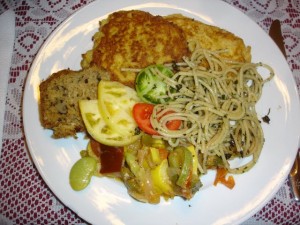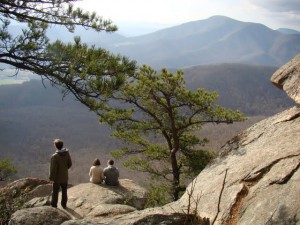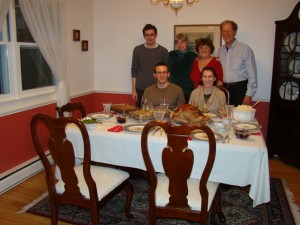Yesterday Nic, Alison and I hiked a lovely 5 1/2 mile loop around and over Cold Mountain, in the nearby George Washington National Forest. Temperatures and flora were those of several weeks ago in the valleys, with the first flowering trees of spring, Serviceberries, in abundance at higher elevations. The online trip description compared the hike to being in Switzerland, which seemed a bit over the top. But once we reached the long summit meadow, and Alison reminded me of the movie, The Song of Music began ringing in my ears, despite the absence of snow-covered peaks. More pictures here.
Mon 19 Apr 2010
A cool hike up Cold Mountain
Posted by Bob under Family and Friends, Hiking/Sauntering, Nature
1 Comment
Mon 12 Apr 2010
Easter Colors
Posted by Bob under Family and Friends
No Comments
Between the forsythia, weeping cherry, crabapple, tulips, dogwood, redbud, and creeping phlox, Easter is a wondrously beautiful time here. It was great to be able to share it with John and family, along with Alison (Nic was up north). For more pictures, click here.
Thu 25 Mar 2010
Early Spring Plantings: Peas to Potatoes
Posted by Bob under Vegetable Garden
No Comments
This year for the first time I am experimenting with fluorescent grow lights, and so “spring planting” actually began on February 19. My makeshift system appears to have worked well, and has produced over 100 seedlings: herbs (mainly parsley and basil), vegetables (peppers, tomatoes, eggplants, and lettuce); and flowers (mainly cosmos and zinnias). It’s been fun to watch their progress and make the necessary adjustments in the lighting, and so far the parsley and lettuce has been transplanted into the early spring garden. In addition, I’ve planted from seed peas (garden, snow, and snap), spinach, swiss chard, arugula, mixed greens, lettuce, and cilantro, along with onion sets. From last fall, two raised beds of four varieties of garlic are also coming along.
In the process, Tim and Megan were pressed into service moving dirt and Nic for removing a stump that turned out to be under ground in my newly-dug potato patch.
Above: Bob cuts seed potatoes into planting pieces; Bob with seed potatoes in three trenches;Â Monika anticipates good German-style eating! (All four potato varieties chosen, Satina, Carola, Romanze, and German Butterball, are German in origin.)
Thu 25 Mar 2010
Wed 17 Feb 2010
Local Picks for Visitors
Posted by Bob under Our New Home
1 Comment
For anyone contemplating a visit to this area, I’ve posted what will continue to be an evolving page about interesting and fun things to do in Nelson County and the surrounding area. It can be accessed by clicking on “Local Picks” in the upper right hand corner of this blog, or more directly at: http://www.nelsoncountyrocks.com/local-picks/
Note: Continuing snowstorms and cold weather outside–which locals say they’ve never seen anything comparable in 20-40 years, depending on whom one talks to, provide ample time for projects like this!
Sat 6 Feb 2010
Winter Snowstorms: Déjà vu X 3
Posted by Bob under Nature, Our New Home
No Comments
When we moved to Virginia, I was under the impression that when it (infrequently) snowed here, the snow generally melted off within a day. The two feet of snow we received in mid-December, which stayed on the ground for weeks, disabused me of that notion! That lesson has been reinforced by three (!) additional snowstorms since then. The latest one, described by the weather service as one of “epic proportions” was actually less serious here than it was to the north in Washington DC and Maryland, but it still added a good foot of snow to what we already had. As of the time of this post, over half a million households in Virginia, Maryland, Pennsylvania and New Jersey are without power, but our home happily is both lit and warm. But since it’s only early February, who knows lays ahead? Click here for more snowscape pictures from these past several weeks.
Family note: Tim has posted pictures from his and Megan’s Xmas visit at his Popcorn Farmer blog: http://www.popcornfarmer.com/2010/01/christmas-2009-part-1/. And Monika has pictures from our visit to Dave and Sue and our latest grandchild, Paityn Marie at her Oma’s World blog at http://oma711.blogspot.com/2010/01/new-beginnings.html
Tue 12 Jan 2010
Winter Reading: Seed Catalogs and more
Posted by Bob under Farms and Food, Vegetable Garden
[2] Comments
I guess most non-gardeners would think I spent a ridiculous amount of time this period of each year poring over seed catalogs. But what gorgeous displays many of them have become, and with the growth of interest in heirloom plants, they are goldmines of historical as well as horticultural information. Who can resist names like Cherokee Trail of Tears Bean, Pennsylvania Dutch Crookneck Squash, Paul Robeson Tomato, Bloody Butcher Corn, or Fife Creek Cowhorn Okra? When combined with all the luscious catalog photos, it’s easy to understand Barbara Kingsolver’s husband’s reported quip in Animal, Vegetable, Miracle that it might be more efficient for her to circle the items that didn’t tempt her, rather the ones that did!
The four catalogs pictured above: Seed Savers Exchange, Baker Creek Heirloom Seeds, Johnny’s Selected Seeds, and Southern Exposure Seed Exchange are my current favorites for varying reasons–vision, diversity, horticultural information, and regional focus, among others. I’ve ordered seeds from all of them and the arrival of their catalogs around the new year feels like a visit from old friends. Recently I’ve also discovered three online catalogs that have nice special features: Cherry Gal not only offers an impressive variety of heirloom seeds but also packets with half the usual number of seeds (generally more than enough for most gardeners) at half the price. Renee’s Garden Seeds, while somewhat more limited in its offering, combines color-coded seeds of different varieties of a given vegetable in the same packet, allowing one to get what one wants in one packet instead of several (I also like the detailed growing information right on the seed packet, rather than having to refer back to the catalog). And Amishland Heirloom Seeds provides unusually-detailed information on many hard-to-find heirloom tomatoes and other vegetables and flowers.
Beyond seed catalogs, retirement has produced a fairly eclectic range of reading, but increasingly I’ve recognized a pattern involving the material bases of culture and history, with a parallel effort to broaden my woefully-limited scientific background. This started with Alfred Crosby’s Ecological Imperialism: The Biological Expansion of Europe, 900-1900, a book that had been sitting on my bookshelf for twenty years, while it influenced others like Jared Diamond, who popularized many of its ideas. Other good reads in this vein were Greg Grandin’s Fordlandia: The Rise and Fall of Henry Ford’s Forgotten Jungle City, and Henry Hobhouse’s Seeds of Change: Five Plants That Changed the World. (A re-reading of Michael Pollan’s Botany of Desire also provided food for thought.) Recently my son Tim came by with The Invention of Air: A Story Of Science, Faith, Revolution, and the Birth of America, which I appropriated for the duration of his stay and found to be a fascinating account of British scientist and radical theologian Joseph Priestley, his long-term intellectual relations with Benjamin Franklin and Thomas Jefferson, and his eventual flight as a political refugee to the backwoods of Pennsylvania. While I’d known about his role in the discovery of oxygen, I was unaware of his being the first to grasp the fact that plants gave off oxygen through what we now understand as photosynthesis. He was in a sense, then, the founder of ecological studies. Currently I’m reading and enjoying Bill Bryson’s A Short History of Nearly Everything, which I’d listened to while driving to and from Virginia, but am getting much more out of by actually reading it. How Bryson manages to serve up such a broad smorgasbord of basic science while being consistently funny and entertaining constantly amazes me. But I’m learning a lot!
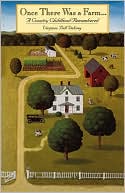 Among other books read: Monika came across Virginia Bell Dabnay’s Once There Was a Farm: A Country Childhood Remembered in our local library, and her enthusiasm led me to read it too. What a great read! Without nostalgia or sentimentality, Virginia Bell Dabnay (1919-1997) provides a beautiful elegy for a life few would want to live today but which nonetheless hauntingly reminds us of what we have lost in our mostly paved-over industrial consumerist society. Dabney describes her growing up on a farm in central Virginia with her strong-willed mother and two sisters (her strange bird of a father lived in Chicago during most of her upbringing, until he moved uncomfortably to the farm when he retired). Coincidentally, in later life, she bought a place not far from our new home in Roseland, which she abandoned in disgust when the Wintergreen development came in the 1970s, moving later on to the Allehgeny Mountains in western Virginia.  With its intimate portrait of the hardships and rewards of rural life in the 1920’s and 1930’s, filled with amazingly-vivid stories and with unobtrusive but powerful insights into family, race relations, friendship, and community, it’s a deeply moving, and for me, unforgettable, book.
Among other books read: Monika came across Virginia Bell Dabnay’s Once There Was a Farm: A Country Childhood Remembered in our local library, and her enthusiasm led me to read it too. What a great read! Without nostalgia or sentimentality, Virginia Bell Dabnay (1919-1997) provides a beautiful elegy for a life few would want to live today but which nonetheless hauntingly reminds us of what we have lost in our mostly paved-over industrial consumerist society. Dabney describes her growing up on a farm in central Virginia with her strong-willed mother and two sisters (her strange bird of a father lived in Chicago during most of her upbringing, until he moved uncomfortably to the farm when he retired). Coincidentally, in later life, she bought a place not far from our new home in Roseland, which she abandoned in disgust when the Wintergreen development came in the 1970s, moving later on to the Allehgeny Mountains in western Virginia.  With its intimate portrait of the hardships and rewards of rural life in the 1920’s and 1930’s, filled with amazingly-vivid stories and with unobtrusive but powerful insights into family, race relations, friendship, and community, it’s a deeply moving, and for me, unforgettable, book.
Sun 20 Dec 2009
Snowbound in Virginia
Posted by Bob under Nature, Our New Home
[5] Comments
We seem to have moved south to Virginia just in time for the biggest snowstorm since 1993 (and the biggest before Christmas since 1936).  With over two feet of snow, we’re effectively snowbound…and loving it. Our freezer continues to yield garden produce from last summer (today for lunch: ginger zucchini soup and yellow squash pancakes) and the snow-covered vistas are beautiful. We expect it to be a number of days before we get our car out. The snow began early afternoon on Friday and continued through Saturday. Today (Sunday) is a beautiful sunny day, but temperatures remain in the 30s, making it likely that the snow will be around for a while yet. Click here for more pictures.
Fri 11 Dec 2009
A Fruitful Gift
Posted by Bob under Family and Friends, Farms and Food, Our New Home
[2] Comments
 At my Rutgers retirement party last spring, my colleagues gave me a generous and thoughtful gift: a gift certificate for fruit trees from Vintage Virginia Apples, an orchard and tree nursery about twenty minutes away, which is trying to keep alive varieties of apples and other fruit no longer commercially available. We had to wait until the trees were dormant, but on Tuesday we picked up five two-year old trees, and the past two days have been spent planting them and protecting them with deer netting. (You may click on the picture of me planting the Grimes Golden for a larger view.)
At my Rutgers retirement party last spring, my colleagues gave me a generous and thoughtful gift: a gift certificate for fruit trees from Vintage Virginia Apples, an orchard and tree nursery about twenty minutes away, which is trying to keep alive varieties of apples and other fruit no longer commercially available. We had to wait until the trees were dormant, but on Tuesday we picked up five two-year old trees, and the past two days have been spent planting them and protecting them with deer netting. (You may click on the picture of me planting the Grimes Golden for a larger view.)
We bought and planted five trees, as follows (descriptions are from VVA’s catalog):
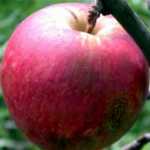 VIRGINIA BEAUTY originated on the property of Zach Safewright in the Piper Gap area of Carroll County, Virginia. In the 1850s, it was given the name Virginia Beauty. Large in size and oblate to truncate in shape, the smooth and glossy, greenish-yellow skin is half to nearly totally covered a shaded brick-red with indistinct red stripes in the greener areas… The yellow flesh is fine-grained, tender, and a light sweetness in flavor… In the early part of the 20th century, the Virginia Beauty was popular for not only dessert, but also for processing, especially for apple preserves. It stores very well and ripens the first weeks of October.
VIRGINIA BEAUTY originated on the property of Zach Safewright in the Piper Gap area of Carroll County, Virginia. In the 1850s, it was given the name Virginia Beauty. Large in size and oblate to truncate in shape, the smooth and glossy, greenish-yellow skin is half to nearly totally covered a shaded brick-red with indistinct red stripes in the greener areas… The yellow flesh is fine-grained, tender, and a light sweetness in flavor… In the early part of the 20th century, the Virginia Beauty was popular for not only dessert, but also for processing, especially for apple preserves. It stores very well and ripens the first weeks of October.
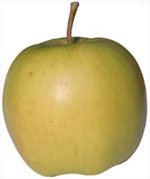 GRIMES GOLDEN was found by Thomas Grimes in Brooke County, West Virginia, 1804, near Wellsburg, West Virginia, where John Chapman, known as Johnny Appleseed, established a nursery with his brother. One of the parents of Golden Delicious. Roundish or slightly oblong in form, small to medium in size, with a greenish-yellow skin, ripening to a clear yellow.. Yellowish flesh is crisp and tender, with a spicy, sweet flavor. A good all-purpose apple, it contains 18.81% sugar that ferments to a 9% alcohol, popular for making hard cider… Self-fertile and an excellent pollinator for other varieties… Ripens in late September and stores very well.
GRIMES GOLDEN was found by Thomas Grimes in Brooke County, West Virginia, 1804, near Wellsburg, West Virginia, where John Chapman, known as Johnny Appleseed, established a nursery with his brother. One of the parents of Golden Delicious. Roundish or slightly oblong in form, small to medium in size, with a greenish-yellow skin, ripening to a clear yellow.. Yellowish flesh is crisp and tender, with a spicy, sweet flavor. A good all-purpose apple, it contains 18.81% sugar that ferments to a 9% alcohol, popular for making hard cider… Self-fertile and an excellent pollinator for other varieties… Ripens in late September and stores very well.
 REINETTE SIMIRENKO may be the same as Wood’s Greening. There is some uncertainty whether it originated as claimed in the garden of P. F. Simirenko in the Ukraine, or in the United States, as Wood’s Greening. It was described in 1895, and was popularized by Soviet cosmonauts, who took the apple into space for dessert. Medium in size, the greenish-yellow skin has a brownish-orange flush, and is russeted in the cavity and dotted on the surface. The finish is waxy. The greenish-white flesh is tender and crisp with a subacid flavor. It bears early and heavily and will also hang long on the tree after ripening. The tree top develops into a wide pyramidal crown and the variety is very drought resistant. It stores well and ripens in October. [Note: it appears that Wood’s Greening came first, and was developed by a family named Wood (no relation as far as I know, but who knows?) in Burlington County, New Jersey in the early 19th century.]
REINETTE SIMIRENKO may be the same as Wood’s Greening. There is some uncertainty whether it originated as claimed in the garden of P. F. Simirenko in the Ukraine, or in the United States, as Wood’s Greening. It was described in 1895, and was popularized by Soviet cosmonauts, who took the apple into space for dessert. Medium in size, the greenish-yellow skin has a brownish-orange flush, and is russeted in the cavity and dotted on the surface. The finish is waxy. The greenish-white flesh is tender and crisp with a subacid flavor. It bears early and heavily and will also hang long on the tree after ripening. The tree top develops into a wide pyramidal crown and the variety is very drought resistant. It stores well and ripens in October. [Note: it appears that Wood’s Greening came first, and was developed by a family named Wood (no relation as far as I know, but who knows?) in Burlington County, New Jersey in the early 19th century.]
We also planted two Black Heart Cherry trees, for which rather little information is available: “BLACK HEART Cherries are a sweet dark fruit on a large tree. Fruit matures early and over a relatively long season.” Our understanding is that they have been grafted from a tree on an old farm in this area.
It will take a little patience, but we’re excited about tasting and sharing these fruits in the future. And heartfelt thanks to my (still-working stiff) colleagues back at Rutgers for this wonderful gift!
Pictures from the Vintage Virginia Apples Harvest Festival
Sun 29 Nov 2009
Our First Virginia Thanksgiving
Posted by Bob under Family and Friends, Our New Home, Vegetable Garden
No Comments
We had much to be thankful for at our first Thanksgiving in Virginia: our transition into retirement and a new sort of life has gone amazingly smoothly and we are loving every minute. And of course we were thankful that Eleanor and Justin came down by train from New York City, and that Nic and Alison came out from Charlottesville.
Wednesday evening I prepared a “local” meal where the key ingredient of each dish came from our garden (fresh or via the freezer): yellow squash pancakes, pesto with spaghetti, three varieties of sunroom-ripened tomatoes, zucchini bread, and a vegetable medley of garden onions, tomatoes, string beans, lima beans, peppers, yellow and green squash, and herbs (click on left picture for a larger view).
On Thanksgiving Day we took “The Plunge” trail to the overlook in the middle picture, as well as driving along the Blue Ridge Parkway and stopping on the way back for a short hike to Crabtree Falls. At Thanksgiving dinner, all agreed that the Polyface Farm turkey was the tastiest we’d ever had (also less fatty, since it got to run around in its life).
More pictures may be seen by clicking here.




